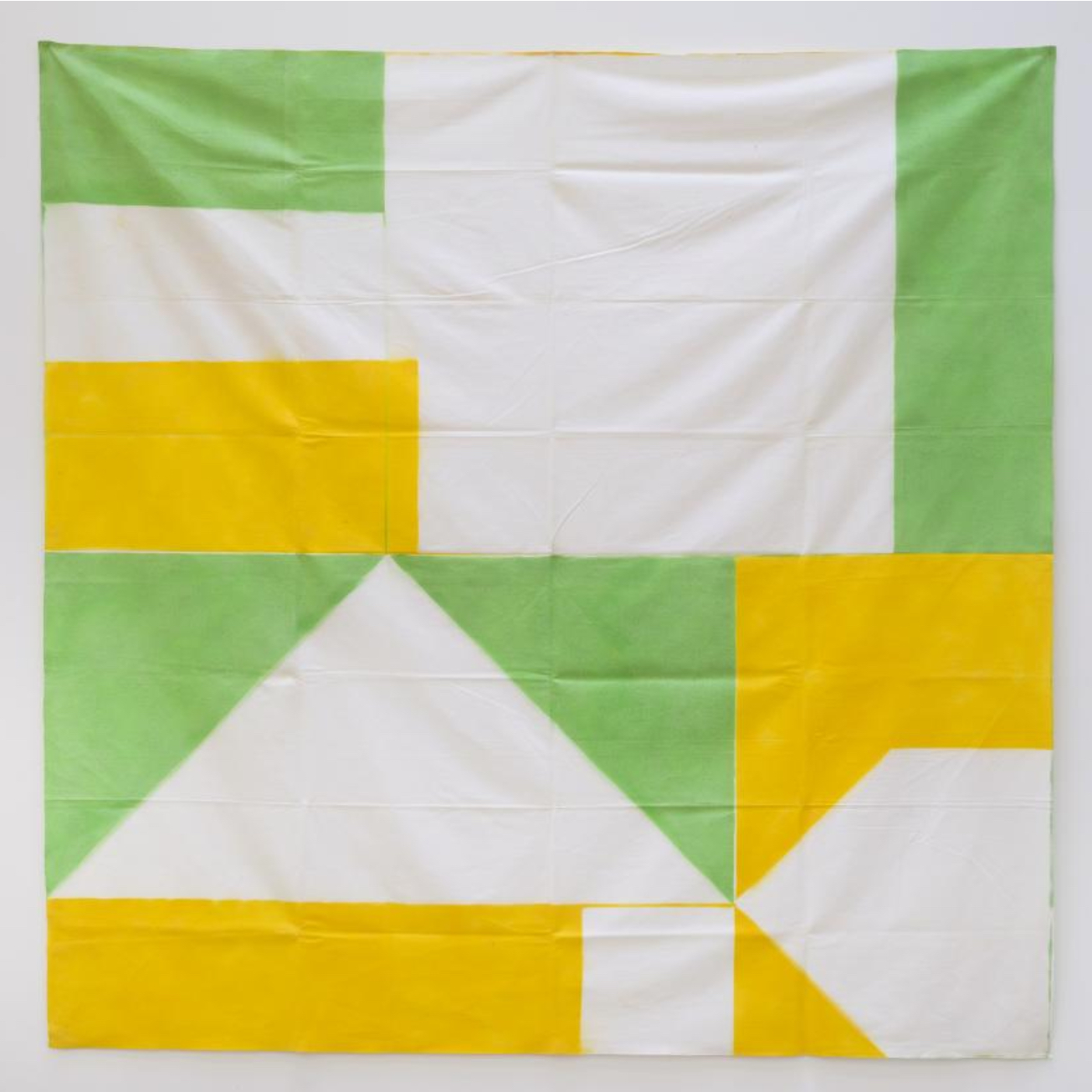
André-Pierre Arnal, Pliage, 1971. Spray paint on canvas, 79 x 40 in.
Supports/ Surfaces
Image Gallery CatalogNovember 4 - December 4, 2014
The Douglas F. Cooley Memorial Art Gallery, Reed College is proud to present an exhibition of works by French artists from the Supports/Surfaces movement.
Monday, November 10 from 5:00—8:00 pm, Reception at the Cooley Gallery
With CANADA co-founder and exhibition co-curator Wallace Whitney.
On view Tuesday, November 4 through Sunday, December 14,
French painting from the Supports/Surfaces movement, 1964–1981.
The exhibition comprises works from 1964 to 1981 by ten of the twelve artists associated with the group: André-Pierre Arnal (b. Nîmes,1939); Vincent Bioulès (b. 1938, Charenton); Pierre Buraglio (b.Charenton, 1939); Louis Cane (b. Beaulieu-sur-Mer, 1943); MarcDevade (b. Paris, 1943–1983); Daniel Dezeuze (b. Alès, 1942); Noël Dolla (b. Nice, 1945); Jean-Michel Meurice (b. Lille, 1938); Bernard Pagès (b. Cahors, 1940); Jean-Pierre Pincemin (b. Paris,1944–2005); Patrick Saytour (b. Nice, 1935); André Valensi (b.Paris, 1949–1999); and Claude Viallat (b. Nîmes, 1936).
Supports/Surfaces is an artistic movement that coalesced in Southern France in the late 1960s through the shared concerns of twelve artists dedicated to liberating painting, and everyday life, from the artistic conventions and social inequities of the post-war period. Invigorated by the protests of May 1968, the artists were inspired, artistically, by the works of Simon Hantaï and Henri Matisse; American Color Field painting (which was on view at the time at the Fournier Gallery in Paris); and Chinese ink painting.
The Supports/Surfaces artists deconstructed painting in terms of its most essential qualities—color, surface, and pliability—embracing its capacity for beauty and touch. Studying Matisse, they collapsed foreground and background into vibrant, lyrical patterns and motifs. As described by Marc Devade: “…the object of a pictorial structure is not therefore the result of the exteriority of formal elements in relation to format: it is, on the contrary, the very form of the structure that develops its own effects,” (Dezeuze 1971). In the 1964 words of Marshall McLuhan, whose writings the artists referenced: the medium is the message.
With a deep love of painting politically fueled by Marxist and psychoanalytic theory, most of the Supports/Surfaces artists rejected “elitist” tools such as fine-art brushes and oil paint, working instead with liquid dyes, spray paint, soot, sponges, stencils, razors, and utility brushes. They worked on fabric, gauze, rope, wood, vinyl, and found objects such as dish towels and table cloths, engaging these surfaces in reverse and from all sides, often blind to the immediate results of their actions. They stained, folded, creased, rolled, burned, and doused their paintings into being, trusting the materials to do their work. Artist Daniel Dezeuze described the movement as “… revolting against the art world and the world in general without having to make anti-art,” (Rubinstein 2004).
A vital aspect of the Supports/Surfaces movement was its participation in French intellectual culture. In 1971, four of the group’s members—Bioulès, Dezeuze, Devade, and Cane—founded the journal Peinture, cahiers théoriques (Painting: theoretical notebooks) in Paris. Working closely with Marcelin Pleynet, the literary editor of the influential journal Tel Quel , and a major Supports/Surfaces advocate, the Peinture editors published Supports/Surfaces writings amidst an astonishing variety of critical texts on art, philosophy, and literature. Absorbing and debating the theories of Karl Marx, Jacques Derrida, Marshall McLuhan, and Louis Althusser, the editors set aboutt heorizing painting and art history as an object of knowledge. In the first issue of Peinture, cahiers théoriques, they declared: “To consider painting as a significant practice takes into account not the object produced, but the work of the maker—not the merchandise, but the productive force: which is to say, the way in which the subject of the painting (the painter) effaces himself in the work (death drive/sublimation) and brings about the creation/deconstruction of the painting,” (Dezeuze 1971). This Marxist/psychoanalytic position privileges the artist’s labor while de-emphasizing the ego and narcissism of the artist—and the viewer.
The first-ever U.S. survey of the Supports/Surfaces group debuted at CANADA, New York, in 2014, curated by CANADA co-founder Wallace Whitney. The current iteration of CANADA's exhibition has been curated for the Cooley Gallery by Stephanie Snyder, in partnership with Whitney and CANADA, New York. Additional loans to the exhibition have been made possible courtesy of Cherry and Martin, Los Angeles, and the Miller Meigs Collection, Portland. Many thanks for their generosity. A full-color catalog, co-published by Galerie Bernard Ceysson and CANADA, New York, is available at the Cooley. Images courtesy and copyright of the artists, CANADA, New York, and Galerie Bernard Ceysson.
References:
Daniel Dezeuze, “Pour un Programme Théorique Pictoral,” in Peinture: cahiersthéoriques , June 1971, no.1
Raphael Rubinstein, “The Painting Undone: Supports/Surfaces,” Art Critical , February1, 2004: artcritical.com
